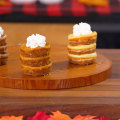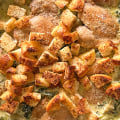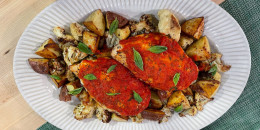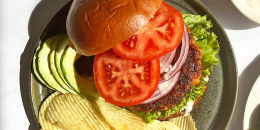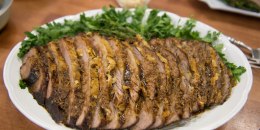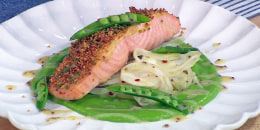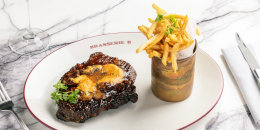Chef notes
This is where I got my start — watching my granny be up all night cooking brisket when I was a little boy. You'd see this big tough piece of meat, then you'd go to sleep and the next day everybody was talking about how good it was. Brisket was her favorite meat, and I felt like I got to be a part of it.
Then, when she got older, I was the only person who made brisket that she would eat. One of the highlights of my life was making her brisket whenever I'd go to see her. So, I felt like brisket was something that I had to master.
Technique tip: Wrapping the brisket in butcher paper part way will help to keep it from drying out.
Ingredients
- 1¼ cups garlic salt
- 1 cup freshly ground black pepper
- 1 (12- to 15-pound) whole beef brisket, with a nice fat cap
- yellow mustard, for rubbing
- 1½ cups Brisket Rub (recipe above)
- wood chunks, oak and pecan
Preparation
For the brisket rub:
In a medium bowl, combine the garlic salt and pepper, and mix thoroughly. Store in an airtight container at room temperature.
For the brisket:
1.Dry your brisket with a paper towel or kitchen towel.
2.Take a little mustard and just give the brisket a nice, even layer all over. Make sure that mustard is rubbed in too, without any clumps.
3.Sprinkle the seasoning on top with a nice, heavy, even layer without any clumps. Go extra heavy on that fat cap on top. Rub the seasoning in to help it stick. Flip the brisket over and hit the bottom. When you're done, you should barely see the meat come through the seasoning.
4.Light your charcoal and get your smoker to 255 F. When the charcoal is ashed out and ready, start with about eight oak chunks and allow it to burn off for 5 to 10 minutes.
5.Load the brisket fat-side-up into the center of your pit, positioning the brisket so that the fat end is pointed toward the firebox. From here, just keep an eye on your temperature and don't open the pit. The brisket needs that hard smoke for the first 3½ to 4 hours, so keep it steady with wood smoke, trying to time it out with adding the wood. Whenever the temperature starts to drop down to 245 F, add more charcoal or wood to the firebox. If it needs more wood, add about four chunks of oak, knowing that the temperature will spike each time.
6.Once you hit the 3-hour mark on your smoke, start blending in a pecan chunk with the oak. Then after the 4-hour mark, you can go to pecan and charcoal for another 2 to 4 hours, or until the brisket gets that nice bark that you're looking for.
7.If you are wrapping your brisket, you should do it between 6 and 8 hours into your smoke, after the brisket has a nice deep bark and is a deep mahogany color. If you are using an instant-read thermometer, the middle of the brisket should be registering around 170 F. After you've wrapped the brisket in butcher paper, return it to the pit. Once it is wrapped, you can raise the heat to as high as 265 F and cook with charcoal only for the rest of the way. Once the brisket is wrapped you do not need more wood — only charcoal.
8.If you are not wrapping your brisket, after 6 hours, you are still going to go with straight charcoal the rest of the way, but you want to make sure to maintain a heat between 245 F and 255 F.
9.Once your brisket has been smoking for 10 hours, you can start checking on your brisket to see if it is done. You should be able to feel a soft, loose jiggle on it, even through the paper (if using). It should feel as if all the fat has softened up and relaxed. If you are using a thermometer, the internal temperature should read around 195 F. I have always checked by feel, but the cool thing is that the internal temperature and my feel test usually match up. If the temperature is right but the brisket doesn't feel right, keep cooking. The internal temperature is just a reference, not a rule.
10.Once the brisket is done, take it out of the pit and let it rest (in the paper, if you are using it) for at least 20 minutes and up to 1 hour. Then, if it is wrapped, open up the paper and let it breathe for another 20 minutes.
11.To carve your brisket, use a serrated knife or a good, sharp carving knife. I cut down the center against the grain and then slice backward toward the tip of the lean end to get those best cuts (right where the lean and the fat meet each other). But if you cooked it right, even the lean end should be juicy as hell.
12.Once the brisket is cut, it has a horrible shelf life. If you're cutting, you should be eating. Cutting causes it to lose its color and dry up real quick. So if you aren't eating the whole thing right away, don't care the whole thing. Instead, just carve the parts you want to eat right then. After that, you're better off saving it in the fridge and then cutting it cold and warming it. "Warm" is the main thing too. Don't heat it up too hot; it just needs to be warm.
13.Leftover brisket will keep, well wrapped, in the refrigerator for up to a week.
Reprinted with permission from "Bludso's BBQ Cookbook: A Family Affair in Smoke and Soul." Copyright © 2022 by Kevin Bludso. Published by Ten Speed Press, an imprint of Penguin Random House.

